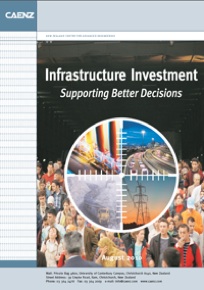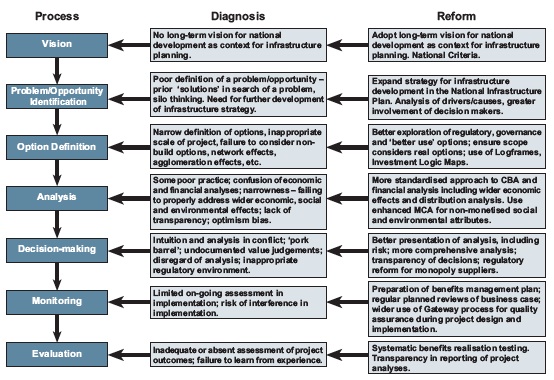Research, consultation, planning, communications



“Infrastructure Investment: Supporting Better Decisions” was a major study undertaken in 2010 by the Centre for Advanced Engineering (CAENZ) analysing public infrastructure investment practice in New Zealand that identified some shortcomings and recommended a range of changes. The report was written by Peter Phillips with Murray Ellis and John Boshier.

“There has been a lot of attention paid recently to reforming the Resource Management Act. Our study, which is has come up with another reform agenda, this time to improve decision-making on major public projects,“ says John Boshier.
“The reform agenda starts with ensuring that projects are linked to overall infrastructure strategy. Special attention is paid to tools to improve the way projects are developed and assessed. We also highlight the need for each major project to have a Benefits Management Plan and for the regular publication of benefits realisation tests which show whether project objectives have been achieved. We believe that transparency is essential in improving the quality of advice and the way decisions are made,” says John Boshier.

“Another key theme is the need for a standardised approach to investment analysis across different sectors. It will then be possible to identify the more productive investments if the same tools are being used by different agencies. This will also reduce the frustration of people developing projects that have to deal with a range of agencies all with different agendas and tests. Our report includes a case study of the New Lynn Transit Centre where public investment in rail will be matched by private investment in commercial buildings as part of a town centre revitalisation programme. The energy of Mayor Bob Harvey and his team was a key factor in ensuring that the potential network benefits of this investment were factored into the decision to go ahead with the rail trench and new bus/rail station”, says John Boshier.
“During the study we have identified where some of these improved methods are starting to be used here. The NZ Transport Agency is now using a method for assessing wider economic benefits imported from the UK. The State Services Commission has already started to roll out the Gateway Review process for quality assurtance throughout the life of a project. We recommend that both of these methods be more widely adopted,” says John Boshier.
The study makes 13 recommendations to support better decisions on infrastructure investment:
-
(1)Augment the Government’s long-term vision and strategy for infrastructure investment with quantified performance indicators and national criteria for project selection, and include these in the National Infrastructure Plan.
-
(2)Operationalise the relationship between strategy, project planning, and evaluation through the use of Logical Framework Analysis which clearly defines the links between ends, means, measures, assumptions and resourcing.
-
(3)Promote the use of Investment Logic Mapping and the inclusion of the governance viewpoint at project inception to add rigour to problem identification, to ensure wide coverage in options definition, and to capture opportunities.
-
(4)Prepare and foster the adoption of a standard portfolio of analytical tools and indicators to ensure comparability of investment proposals that would capture:
-
 directly monetised user benefits (as in Treasury’s The Primer);
directly monetised user benefits (as in Treasury’s The Primer); -
 wider economic effects;
wider economic effects; -
 productivity gains;
productivity gains; -
 network effects;
network effects; -
 life cycle costing;
life cycle costing; -
 social effects that can be monetised;
social effects that can be monetised; -
 distribution of effects between stakeholders/communities;
distribution of effects between stakeholders/communities; -
 effects that cannot be monetised (principally social and environmental).
effects that cannot be monetised (principally social and environmental). -
(5)Undertake investigations to show how the value of “real options” might be incorporated into analyses of infrastructure investments.
-
(6)Develop a process using the standardised project assessments to present the economic benefits and productivity gains of projects and programmes in different sectors to inform the discussion of budget allocation between sectors and develop a portfolio of high-performing investments.
-
(7)Extend the use of the State Services Commission’s Gateway Review Process across the public sector including agencies and local government.
-
(8)Require a Benefit Management Plan for every major infrastructure project.
-
(9)Revise investment tests for monopoly infrastructure (such as the National Grid and the permanent way for rail) to take into account wider economic effects.
-
(10)Investigate benefit realisation on a range of past investments to determine lessons that can be learned and identify exemplars for the promotion of good practice to be used with the portfolio of methods.
-
(11)Undertake a pilot benchmarking project across a range of central and local government agencies on the quality of analytical methods and tools used for infrastructure investment.
-
(12)Establish an on-going programme of publication of analyses of investment proposals to provide increased transparency on infrastructure investment advice and decision-making.
-
(13)Undertake an upgrade of the statistics on infrastructure to facilitate better planning, monitoring and evaluation.
The CAENZ study was carried out with the support of a number of local government, infrastructure and industry organisations, most notably the NZ Council for Infrastructure Development (NZCID).
Contributing research authors on the study were: Arthur Grimes, Motu Economics; Kel Sanderson and Ganesh Nana, BERL Economics; Rob Steel, Opus International Consultants; Peter Phillips, Dialogue Consultants; Murray Ellis, Dialogue Consultants; and Tony Nicklin, Director of CAENZ.
Case study authors were: Nik Vorster, Auckland Regional Transport Authority; Mayor Bob Harvey and Alan Rodgers-Smith, Waitakere City Council; Deborah Corneby, Watercare Services Ltd; and Ben King, Ernst & Young.
A copy of the summary report can be obtained from the Downloads page.
All content copyright © Dialogue Consultants Ltd.